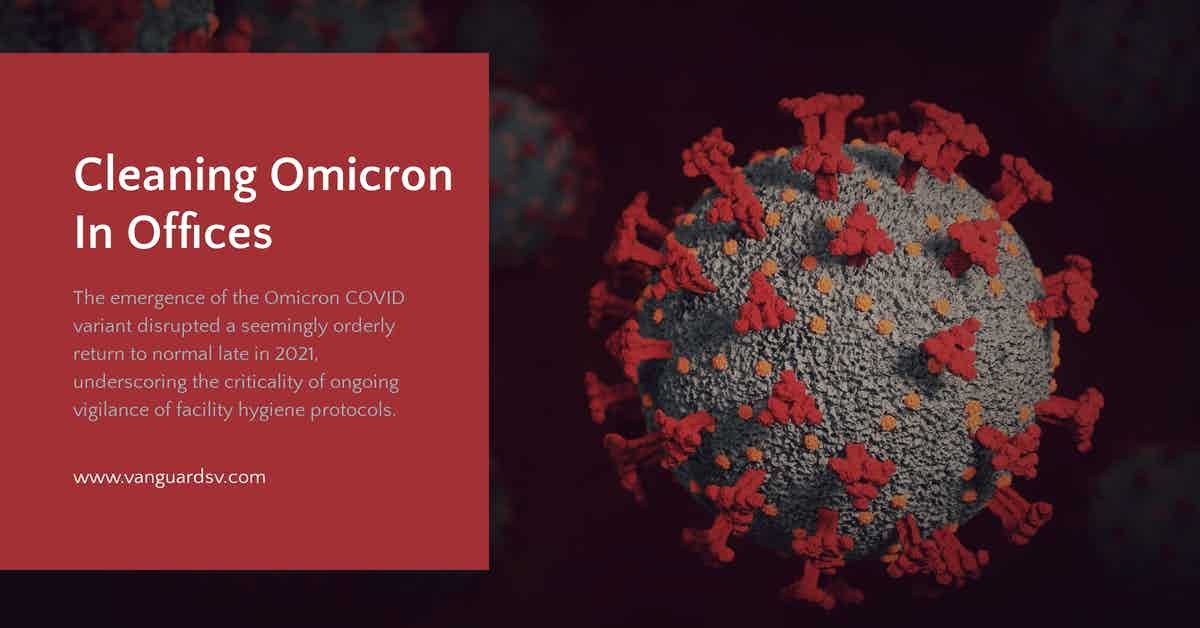The emergence of the Omicron COVID variant disrupted a seemingly orderly return to normal late in 2021, underscoring the criticality of ongoing vigilance of facility hygiene protocols.

Keeping Omicron Out of Your Office
Preventing the spread of the Omicron variant, as well as other pathogens and wintertime bugs, is critical for the health and welfare of your business, workforce, and customers.
Presently, news regarding Omicron infections is mixed, with reported cases decreasing and hospitalizations leveling off, yet both metrics remain troublingly high.
According to the New York Times;
New coronavirus cases have started to fall nationally, signaling that the Omicron-fueled spike that has infected tens of millions of Americans, packed hospitals, and shattered records has finally begun to relent.
More and more states have passed a peak in new cases in recent days, as glimmers of progress have spread from a handful of eastern cities to much of the country.
Through Friday, the country was averaging about 720,000 new cases a day, down from about 807,000 last week. New coronavirus hospital admissions have leveled off.
Omicron Cases Appear to Peak in U.S., but Deaths Continue to Rise
The spike in cases combined with the ongoing challenge of the Delta variant and the continued disruption to daily life has resulted in easily predictable consumer and workforce demands for cleaner, safer facilities.
A new survey conducted in October 2021 from the Cleaning Coalition of America, an organization that represents contract cleaning professionals around the country, asked 1,800 U.S. workers (vaccinated and unvaccinated) to weigh in on their preferences.
An overwhelming 93 percent of vaccinated respondents and 82 percent of unvaccinated respondents cited workplace cleaning protocols as important, with 77 percent of workers wanting the workplace cleaned at least daily.
Combatting Omicron in the Office
Omicron, like other COVID variants, is enveloped, making it highly susceptible to inactivation with regular soap and water and UV-C lighting--both of which destroy the outer protein layer (lipid) of the SARS-CoV-2 virus.
Additionally, the US Environmental Protection Agency (EPA) has registered several disinfectants with less corrosive or toxic primary ingredients, such as citric acid and hydrogen peroxide, as effective against SARS-CoV-2 on numerous non-porous surfaces.
Further, chemicals conventionally applied via electrostatic spraying systems have been registered with the EPA as effective against SARS-CoV-2 and its variants.
Combining these tools and information into a routine environmental cleaning program will establish a formidable defense against the surface spread of SARS, as well as other common pathogens and pathogenic bacteria, including influenza, norovirus, and the various viruses that cause the common cold.
In general, your office should focus on:
- Improving HVAC filtration to include a minimum MERV-13 filter and UV-C air sanitization, as applicable.
- Increasing mechanical airflow through the office with the HVAC system.
- Cleaning occupied spaces within the office every day using a commercial-grade soap-based detergent applied with microfiber.
- Targeting high-touch areas of the facility to sanitize throughout the day with an EPA-registered disinfectant selected from the EPAs List-N database--preferably one, as previously mentioned, with a safer active ingredient than Quats or bleach.
- Deep cleaning and sanitizing the entire facility at least once per month--more often in high-capacity facilities or in communities with a high level of pathogen transmission.
For areas that lack easy access to handwashing stations or facilities that are poorly ventilated, especially with high capacity foot traffic throughout the day, the US Centers for Disease Control and Prevention recommends increased cleaning and targeted sanitization frequencies.
According to CleanLink;
In areas where no suspected or confirmed infected occupants resided, the Centers for Disease Control and Prevention (CDC) says a one-time daily clean is sufficient.
The CDC also emphasized areas that lack handwashing/sanitizer stations, or are poorly ventilated, as targets for daily or multi-frequency cleans.
Takeaway
Scientifically proven environmental cleaning and sanitization methods combined with well-documented handwashing and awareness practices will help reduce the rate of transmission of SARS-CoV-2 now and help prevent future outbreaks of COVID and other pathogens.
Labor shortages have resulted in skilled staffing issues for in-house custodial departments, future underscoring the ongoing value of outsourcing.
Outsourcing is a proven method for onboarding highly in-demand cleaning and sanitization services and experience for a fraction of the price of maintaining a similar service in-house.
If you would like more information regarding the effectiveness of high-performance infection prevention and control measures, or if you would like to schedule a free, no-obligation on-site assessment of your facility's custodial needs, contact us today for a free quote!
In Bakersfield, CA, call (661) 437-3253
In Fresno, CA, call (559) 206-1059
In Valencia, CA, or Santa Clarita, CA, call (661) 437-3253
In Palmdale, CA or Lancaster, CA, call (661) 371-4756

